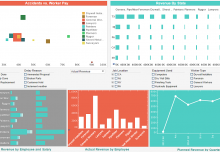Frustrated by the lack of flexibility and slow turnaround times of traditional BI tools, business teams are turning to self-service analytics to enable data-driven decision making and improved collaboration at every level of the organization.
Self-service analytics tools are breeding a new crop of data users, which Gartner refers to as citizen data scientists or “a person who creates or generates models that leverage predictive or prescriptive analytics but whose primary job function is outside of the field of statistics and analytics.”
Citizen data scientists can come from any part of your organization. From marketing to management, everyone at your organization can dive into a self-service analytics tool. Here are a few team members you might not realize would benefit:
1. Product
When it comes to exchanging data, product and business teams often struggle to get on the same page. Product teams analyze information gathered within the tool to drive their decision making about the product roadmap, while business teams rely on their own data from other sources to guide their own. This can lead to a crippling disparity between the direction of the product and the sales and marketing activities surrounding it.
Self-service business intelligence software can help product and business teams align around a shared view of all BI data, such as:
- Which features in the product are actually getting used? Which are not?
- Can we reduce investment in certain features? Are there other capabilities that customers would prefer for us to expand?
- What elements of the product require the most time to maintain? How can we reduce/optimize that time to provide greater value to the customer?
- Which elements of the product generate the most negative feedback from customers? How should we work to improve them?
2. Sales
Sales funnels, especially for SaaS companies, are incredibly complex. And without effective data visualization, it’s easy for sales teams to be running in a hundred directions at once. Eager to win business, sales people can fall into a trap of chasing cold leads, while unknowingly neglecting those that are most likely to generate real business. Self-service BI tools help sales teams align around their goals, by helping them identify patterns, such as:
- What qualities make someone most likely to convert?
- What qualities make someone unlikely to spend?
- Which types of leads should be pursued, at what frequency, and when in the buying process?
Properly utilizing a self-service BI tool can help sales teams function like a well-oiled, revenue generating machine.
3. Leadership
For management, self-service analytics can provide access to metrics that assess the health of the organization from every department and in a collaborative view. This is essential in crafting strategic direction and being able to make quick decisions to keep up with the pace of today’s business world.
Self-service analytics tools also make it easier for management to provide transparency — a quality that is much needed, but often missing from organizations. For company-wide townhalls or one-on-one meetings, critical data can be pulled that shows where the organization is headed, and how individual teams play a role.
4. Marketing
Product marketing managers, for example, often struggle to measure the impact of their efforts. Outside of retrospectively analyzing trends, they don’t have visibility into how their efforts to increase product expertise, share customer stories, and communicate with technical teams are improving customer acquisition or retention. Leveraging a self-service BI tool can keep product marketers on the pulse of how their efforts are (hopefully) improving key metrics along the customer journey.
Having access to a self-service BI tool also allows social media marketers to better understand how their efforts fit into the larger marketing engine. While likes, follows, and other social metrics can be measured by most social media tools, BI tools can help social media marketers explore how those engagement metrics translate into leads and sales.
One of the hardest marketing tactics to prove ROI for are events, especially if the goal is brand awareness or general relationship building versus lead generation. Armed with self-service analytics, events teams can better strategize for their events in advance by evaluating the audience and the impact of other marketing strategies. With company-wide insight, they have a better chance of measuring any post-event outcomes as well.
5. HR and Individual Managers
Many HR teams are turning to performance management tools to help with employee learning, development, and promotion structure. But these tools aren’t helpful without metrics to measure employee progress to goals. Using self-service analytics, HR can provide greater insight to inform performance reviews and plan for development.
And because self-service analytics are accessible by anyone at the organization, anytime individual managers can benefit as well. They can set goals with their direct reports and use analytics to show how those individual goals tie into the larger organizations. They can also pull progress metrics for regular check ins so they are better informed about where employees deserve the most praise and where they need the most coaching.
6. Customer Success
Customer churn is ultimately a measure of effectiveness for customer success teams. The ability to understand at any point both the rate of churn and the specific factors affecting it can help these teams focus their efforts on areas of greatest need. Customer success teams can gain a better understanding of the customer journey. Answering questions such as:
- What creates good experiences?
- When do customers leave?
- Which customer segments are most likely to churn and why?
- When do customer most want to hear from a success rep?
Final Thoughts
Citizen data scientists can truly come from any part of your company. But it’s important to note that equally, if not more, important than providing access to self-service analytics is training employees on how to use the tool. Once you do, you’ll empower team members from individual operators to department managers to learn more, make better decisions, and play their role in driving the organization forward.
About the Author
 Maja Majewski is a contributor to TechnologyAdvice, and content and social media marketer in the B2B tech space. She is passionate about process improvement and productivity. Connect with her on LinkedIn.
Maja Majewski is a contributor to TechnologyAdvice, and content and social media marketer in the B2B tech space. She is passionate about process improvement and productivity. Connect with her on LinkedIn.








